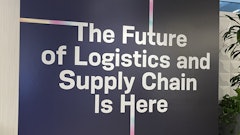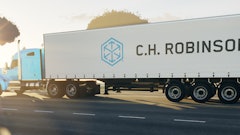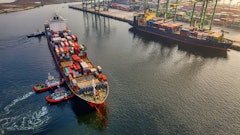
Handheld mobile computers are a common site in the DSD (direct story delivery) arena. That's because today's devices contain a wealth of information and tools, such as GPS and inventory management software, that enable route drivers to be more productive during the day, while reducing costs.
A driver's day actually begins to take shape the night before, with the downloading of sales information from his day.
"He knows what he needs to have on his truck when he comes back from his day," says Charles Gaskamp, IT manager for Blue Bell Creameries, Burnham, TX. Blue Bell recently began outfitting its drivers with handhelds--Motorola NC70s--to keep track of their routes. "He can send that data to us and back at the warehouse they can be pulling the inventory that he's going to need the next day."
Gaskamp says this makes the loading process simpler and quicker, eliminating the time the driver has to spend in line in the morning, waiting for his truck to get loaded. Less time at the warehouse means more time the driver can spend making deliveries and taking orders for their product. Productivity is further enhanced because when a driver grabs his handheld in the morning it already has the route he's going to run programmed into it.
"Having the actual bill of laden to be delivered right there in the driver's hand, in non-paper form, actually increases their productivity," says Frank Moreno, vice president of marketing and product management for Manchester, NH-based Cadec. "They don't have to worry about losing pages or flipping through sheets of paper on the road. They scan the pallet and immediately know what's designated for the next customer. It's an electronic clipboard that is synchronized with dispatch and routing and even customer service."
Mobileaware, based in Cranberry, NJ, is a provider of mobile service infrastructure and manages mobile data solutions. One of its customers, a beverage manufacturer and distributor, used Mobileaware's applications to create customized middleware software that synchs the driver's handheld with the company's back end server, allowing the back office to do scheduling and ordering, as well as continual updates to the handhelds of their delivery drivers.
The updates give them guidance as to where they should be going, what they should be delivering and what they should be picking up during their day.
"This contributes to what they call 'the perfect load,'" says Todd Shingler, CEO for Mobileaware. "With this updated information, the drivers go out to their trucks in the morning, which are sealed up and loaded with only the beverages they're supposed to deliver."
The driver signs off on the load, with the expectation that he's going to deliver just what has been ordered, nothing more or less and that he'll return at the end of the day with an empty truck.
Telematics Integration
Handhelds can now integrate the information from a truck's telematics system, providing a driver with the kind of real-time information that he needs to do his job, at hand's length. This means that delivery people are able to utilize GPS-enabled technology, which is turning out to be a cost-savings bonanza for food companies.
Motorola, Schaumburg, IL, conducted a survey on the value of GPS technologies for mobile field workers. The survey found that respondents reported an average reduction in distances traveled by their workers of 231.2 miles per week and an annual fuel savings of $51,582 per driver. This could make for a potential industry-wide annual fuel savings of $53 billion.
"Companies are also optimizing their routes as a result of utilizing GPS technologies on drivers' handhelds," notes Jerry Mcnerney, senior director at Motorola. "They can go from point A to point B and do it in a much safer, more deliberate fashion and also take miles out of the equation."
In addition, the Motorola survey states that enterprises employing GPS saved an average of 54 minutes per day, which translates into an annual recouped labor savings of $5,484 per employee and $5.4 million per enterprise.
The integration of new technology into the handheld also allows the time synchronization of a route through the routing application.
"You can have specific customer service information that is sent out to the cab about the destination of your next delivery," says Cadec's Moreno.
This information can be accessed by a driver's handheld device and can include updated delivery instructions and other information that increases the productivity of the driver. Moreno says that through this same telematics system, arrival times can be routed through the back office, which can notify customers about the specific time they can expect a driver to arrive at. With this information, a customer can actually stagger arrival times at the dock door and prevent congestion.
"We're seeing that customers are slotting time slots so that a vehicle can arrive in a very short window of time and the driver can unload his goods and leave, in order that the next truck can come in and make its deliveries unencumbered," notes Motorola's Mcnerney. The resulting shorter unload time boosts the number of deliveries a driver can make during the day.
Sign On The Dotted Line
Once the driver offloads his product at the dock door, the handheld, via electronic signature capture, can close the deal in a lightning fast manner, simplifying the entire process for the driver.
"It eliminates paperwork and automates the process, reducing time from order to cash for the company," explains Cadec's Moreno. In addition, there are other important advantages to the electronic signature capture process, especially in terms of reconciliation. Both customer and distributor need to see signatures in order to verify that a transaction was properly completed.
"Confirming delivery is very important. Sometimes customers will actually lie and say they didn't get that sixth case of ice cream," notes Jeff Nixon, product manager for Retalix Ltd., Plano, TX, which provides integrated enterprise-wide software solutions for the food industry. "All the driver has to do is give the guy the handheld and say 'look, yes you did get it.'" Nixon says customers are less likely to try something like that again when that happens. "The scanner doesn't lie. It actually saves distributors a lot of money every year and helps with delivery reconciliation."
In fact, thanks to the proliferation of handhelds on the delivery route, the whole issue of DSD route accounting is being rendered moot for companies.
"For every 100 drivers, a company can save $80,000 a year," says Nixon. "Companies are saving on shortages, overages and even damages. The ambiguity is being eliminated."
Mobileaware's Shingler says that before his beverage customer employed their handheld solution, there was a lot of merchandise on their trucks at the end of the day.
"Orders would get messed up, delivery people would deliver incorrect product and they would have to swap items out as a result. They would end up with product in the truck at the end of the day shouldn't have been in there."
With the software that is available today for handhelds, customers like Mobileaware's can refine the in-store ordering process to such a degree that the delivery person is able to walk into a store, pull up the history of what's been ordered during the same week last year, or when there was a week with similar weather and they can provide complete ordering guidance to the customer right there on the spot.
"It's so incredibly convenient these days. The order goes back immediately to the warehouse where they can start pulling those beverages for delivery the next day."
Retalix's Nixon says its system handles backhauls as well. As soon as drivers receive their handhelds, they know all the stops they have to make for the day. They will also know whether the stop is a drop off or a pick up. "The handheld spells it out for him and thereby eliminates confusion."
Closing The DSD Loop
Traditional DSD route accounting was not a closed loop. But thanks to the mobile computer, the process is fast becoming one. The driver can take pictures of damaged product with the camera installed on the handheld, he can scan UPC codes and use the RFID feature now available to confirm what and how much is being delivered. And, with the various types of communications connectivity, such as wireless 802.11, the driver can even send invoices directly to the customer's computer, bringing them directly into the closed loop system.
"What you're finding is that they're taking inventory with these devices, doing merchandising in-store and even doing price optimization. In many ways the delivery person is now the eyes and ears of the manufacturer/distributor as they go through the daily activities of the job," says Motorola's Mcnerny.
"This is actually making everyone's lives easier," says Blue Bell's Gaskamp. "We already know how much inventory is in the driver's truck at the end of the day because he's downloaded all of that information and already sent it to us, which means the driver doesn't have to come in and spend an hour trying to reconcile his paperwork. He can just put the handheld in the cradle and call it a day."

























